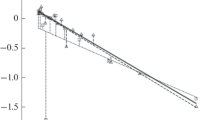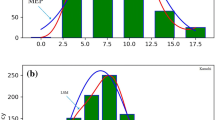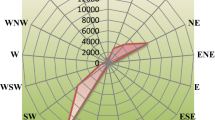Abstract
Purpose
The power–duration relationship has been variously modelled, although duration must be acknowledged as the dependent variable and is supposed to represent the only source of experimental error. However, there are certain situations, namely extremely high power outputs or outdoor field conditions, in which the error in power output measurement may not remain negligible. The geometric mean (GM) regression method deals with the assumption that also the independent variable is subject to a certain amount of experimental error, but has never been utilized in this context.
Methods
We applied the GM regression method for the two- and three-parameter critical power models and tested it against the usual weighted least square (WLS) procedure with our previous published data.
Results
There were no significant differences between parameter estimates of WLS and GM. Bias and limit of agreements between the two methods were low, while correlation coefficients were high (0.85–1.00).
Conclusions
GM provided equivalent results with respect to WLS in fitting the critical power model to experimental data and for its conceptual characteristics must be preferred wherever concerns on the precision of P measurement are present, such as for in-field power meters.



Similar content being viewed by others
Abbreviations
- 2-p:
-
Two-parameter critical power model
- 3-p:
-
Three-parameter critical power model
- CP:
-
Critical power
- GM:
-
Geometric mean regression method
- k :
-
Time asymptote of the critical power model
- P :
-
Mechanical power output
- P 0 :
-
Power limit of the critical power model as time to exhaustion approaches 0 s
- SEE:
-
Standard error of the estimate
- T lim :
-
Time to exhaustion
- W′ :
-
Curvature constant of the critical power model
- WLS:
-
Weighted least square regression method
- ε P :
-
Absolute error in power output measurement
- ε Tlim :
-
Absolute error in time to exhaustion measurement
References
Black MI, Jones AM, Blackwell JR, Bailey SJ, Wylie LJ, McDonagh STJ, Thompson C, Kelly J, Sumners P, Mileva KN, Bowtell JL, Vanhatalo A (2017) Muscle metabolic and neuromuscular determinants of fatigue during cycling in different exercise intensity domains. J Appl Physiol 122:446–459
Brace RA (1977) Fitting straight lines to experimental data. Am J Physiol 233:R94–R99
Ebert TA, Russell MP (1994) Allometry and model II non-linear regression. J Theor Biol 168:367–372
Faude O, Hecksteden A, Hammes D, Schumacher F, Besenius E, Sperlich B, Meyer T (2017) Reliability of time-to-exhaustion and selected psycho-physiological variables during constant-load cycling at the maximal lactate steady-state. Appl Physiol Nutr Metab 42:142–147
Hinckson EA, Hopkins WG (2005) Reliability of time to exhaustion analyzed with critical-power and log-log modeling. Med Sci Sports Exerc 37:696–701
Jones AM, Vanhatalo A, Burnley M, Morton RH, Poole DC (2010) Critical power: implications for determination of V̇O2max and exercise tolerance. Med Sci Sports Exerc 42:1876–1890
Ludbrook J (2012) A primer for biomedical scientists on how to execute model II linear regression analysis. Clin Exp Pharmacol Physiol 39:329–335
Maier T, Schmid L, Müller B, Steiner T, Wehrlin J (2017) Accuracy of cycling power meters against a mathematical model of treadmill cycling. Int J Sports Med 38:456–461
Morton RH (1996) A 3-parameter critical power model. Ergonomics 39:611–619
Morton RH, Hodgson DJ (1996) The relationship between power output and endurance: a brief review. Eur J Appl Physiol Occup Physiol 73:491–502
Poole DC, Ward SA, Gardner GW, Whipp BJ (1988) Metabolic and respiratory profile of the upper limit for prolonged exercise in man. Ergonomics 31:1265–1279
Schennach SM (2016) Recent advances in the measurement error literature. Annu Rev Econom 8:341–377
Vinetti G, Fagoni N, Taboni A, Camelio S, di Prampero PE, Ferretti G (2017) Effects of recovery interval duration on the parameters of the critical power model for incremental exercise. Eur J Appl Physiol 117:1859–1867
Vinetti G, Taboni A, Bruseghini P, Camelio S, D’Elia M, Fagoni N, Moia C, Ferretti G (2019) Experimental validation of the 3-parameter critical power model in cycling. Eur J Appl Physiol 119:941–949
Author information
Authors and Affiliations
Contributions
GV and GF conceived the study; GV analyzed the data; all authors interpreted the results; GV drafted the first version of the manuscript; all authors edited and revised the manuscript and approved the final version before submission.
Corresponding author
Ethics declarations
Conflict of interest
The authors declare that they have no conflict of interest.
Additional information
Communicated by Jean-René Lacour.
Publisher's Note
Springer Nature remains neutral with regard to jurisdictional claims in published maps and institutional affiliations.
Appendix
Appendix
The developments detailed in this Appendix describe how to apply the GM method to the hyperbolic function expressed in Eq. (1). The interested reader can refer to Ludbrook (2012) for practical considerations on linear GM regression and to Ebert and Russell (1994) for an example of adaptation of GM to nonlinear functions, as in the present study.
The assumption behind GM regression is that the ratio between the magnitude of the absolute error in y and in x is similar to the absolute slope of the fitted curve (Brace 1977). In the case of Eq. (1) we set y = Tlim and x = P, thus the slope is equal to:
Is this compatible with the ratio between the magnitude of the absolute error in Tlim and P (εTlim/εP)? Yes, both for biological and technological reasons. We know in fact that εTlim and εP are Tlim and in P are proportional to Tlim and P, respectively thus:
Inserting (1) into (3):
Therefore,
Thus, the assumption required for GM regression is met. Since GM is independent of the choice of the dependent variable, the demonstration is still valid when inverting x and y.
We, therefore, define the loss function as the grey area of Fig. 1, that is absolute difference between the rectangles formed by the thin lines and the integral of the function in the same P interval (white area between the curve and the P-axis). For a generic data point with coordinates (Pi, Ti)
It is noteworthy that Eq. (6) in this formulation has always a positive value thus there is not the need of a modulo operator. Solving and simplifying yields to the following loss function:
By setting k = 0 we obtain the 2-p version of the loss function, while \(k=-\frac{{W}^{^{\prime}}}{{P}_{0}-\mathrm{C}\mathrm{P}}\) leads to the alternative parameterization of Eq. (1) (Morton 1996). The commands for SPSS are derived from this demonstration are reported Table
2, although it must be remembered that equivalent results are granted if starting the demonstration assuming P instead of Tlim as the dependent variable.
Rights and permissions
About this article
Cite this article
Vinetti, G., Taboni, A. & Ferretti, G. A regression method for the power–duration relationship when both variables are subject to error . Eur J Appl Physiol 120, 765–770 (2020). https://doi.org/10.1007/s00421-020-04314-8
Received:
Accepted:
Published:
Issue Date:
DOI: https://doi.org/10.1007/s00421-020-04314-8




